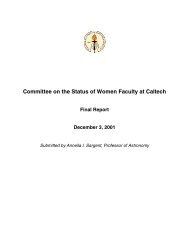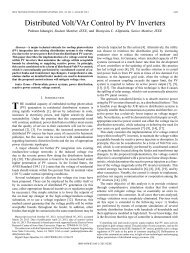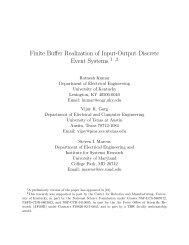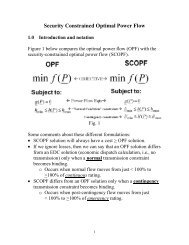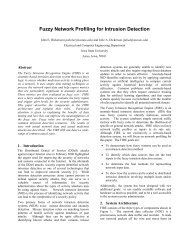Linearized Analysis of the Synchronous Machine for PSS Chapter 6 ...
Linearized Analysis of the Synchronous Machine for PSS Chapter 6 ...
Linearized Analysis of the Synchronous Machine for PSS Chapter 6 ...
You also want an ePaper? Increase the reach of your titles
YUMPU automatically turns print PDFs into web optimized ePapers that Google loves.
ΔE&<br />
'<br />
q<br />
⎛ 1<br />
= −<br />
⎜<br />
⎝ K<br />
3τ<br />
'<br />
⎛ K<br />
ω ⎜<br />
−<br />
Δ & =<br />
⎝ τ<br />
j<br />
Δ & δ =<br />
2<br />
( Δω ) ω<br />
B<br />
do<br />
⎞<br />
⎟ΔE'<br />
⎠<br />
⎞<br />
⎟ΔE'<br />
⎠<br />
q<br />
q<br />
⎛ K<br />
−⎜<br />
⎝ τ<br />
j<br />
⎛ K<br />
−<br />
⎜<br />
⎝τ<br />
'<br />
1<br />
4<br />
do<br />
⎞ ⎛ 1<br />
⎟Δδ<br />
+<br />
⎜<br />
⎠ ⎝τ<br />
'<br />
⎞ ⎛ ⎞<br />
⎟ δ ⎜<br />
1<br />
Δ + ⎟ΔT<br />
τ<br />
⎠ ⎝ j ⎠<br />
do<br />
m<br />
⎞<br />
⎟ΔE<br />
⎠<br />
FD<br />
(6.79)<br />
The LaPlace trans<strong>for</strong>m <strong>of</strong> <strong>the</strong> above equations results in <strong>the</strong><br />
following relations:<br />
K<br />
3<br />
K<br />
3K<br />
4<br />
ΔE'<br />
q<br />
=<br />
ΔE<br />
FD<br />
−<br />
Δδ<br />
1 + K<br />
3τ<br />
'<br />
d 0<br />
s 1 + K<br />
3τ<br />
'<br />
d 0<br />
s<br />
1<br />
Δω<br />
= ( ΔTm<br />
− ΔTe<br />
)<br />
sτ<br />
j<br />
(*)<br />
1<br />
Δδ<br />
= Δω<br />
s<br />
where <strong>the</strong> variables ΔE’ q , Δω, and Δδ represent LaPlace trans<strong>for</strong>ms<br />
<strong>of</strong> <strong>the</strong>ir corresponding time-domain functions. Two additional<br />
relations may be obtained as well, according to <strong>the</strong> following:<br />
ΔT<br />
e<br />
ΔV<br />
t<br />
=<br />
=<br />
K<br />
K<br />
1<br />
5<br />
Δδ<br />
+<br />
Δδ<br />
+<br />
K<br />
K<br />
2<br />
6<br />
ΔE'<br />
q<br />
ΔE'<br />
q<br />
+ DΔω<br />
(**)<br />
Finally, we note that E FD , <strong>the</strong> stator EMF produced by <strong>the</strong> field<br />
current and corresponding to <strong>the</strong> field voltage v F , is a function <strong>of</strong><br />
<strong>the</strong> voltage regulator. Under linearized conditions, <strong>the</strong> change in<br />
E FD is proportional to <strong>the</strong> difference between changes in <strong>the</strong><br />
reference voltage and changes in <strong>the</strong> terminal voltage, i.e.,<br />
Δ EFD<br />
= G<br />
e(<br />
s )( ΔVref<br />
− ΔVt<br />
) (***)<br />
where G e (s) is <strong>the</strong> transfer function <strong>of</strong> <strong>the</strong> voltage regulator.<br />
4




